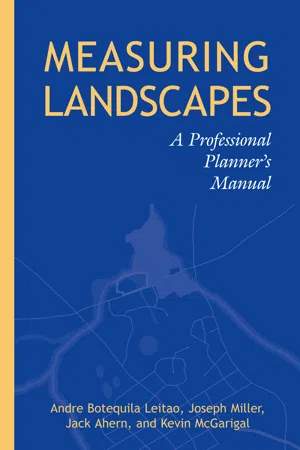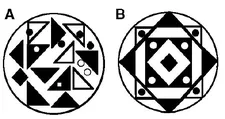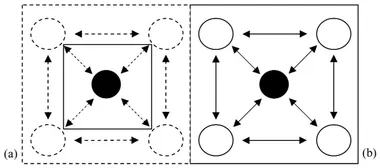To use landscape pattern metrics appropriately, it is important to understand their scientific context. While the range of applications for landscape metrics may be diverse, most metrics were developed and adapted specifically for landscape ecological research applications. Therefore, the more knowledge planners possess about landscape ecology principles and concepts, the easier it becomes for them to use landscape metrics appropriately.
In this handbook we have adopted a widely accepted definition of landscape: a kilometer-wide mosaic over which particular local ecosystems and land uses recur (Forman and Godron 1986; Forman 1995). A landscape mosaic is comprised of spatial elements (e.g., patches, corridors, and matrices, described below), and landscape metrics help to measure, describe, and understand the significance of these elements or their spatial pattern. Although we focus on a spatial approach to understand landscapes, we acknowledge the need to perceive landscapes as multidimensional entities that can be understood from a transdisciplinary perspective (see Box 1.1). Additionally, we find the spatial approach to understanding landscapes to be compatible with other approaches from other disciplines including: anthropology, sociology, history, and economics.
Landscape ecology focuses on the relationship between landscape structure and function and the ways landscapes change over time. To introduce this we will first examine the conceptual fundamentals of landscape structure and function. Then we will examine fundamental conceptions of landscape change, focusing on issues that are highly relevant for planning.
1.3.1. Landscape Structure
Landscape structure is a description of the spatial relationships among ecosystems, or more specifically the distribution of energy, materials, and species in relation to the size, number, types, and configurations of ecosystems.
There are several principal ways to describe the structure of landscapes, each using different kinds of data. With point data, the property of interest is usually the geographic location of each point, although measured attributes at each location may also be of interest. Linear networks within a landscape may be useful in the study of hydrologic systems (such as rivers and streams), wildlife corridors, or transportation and energy networks. Surficial, or continuous surface data is useful to address landscape variability as gradients (McGarigal and Cushman 2005). Categorical data assumes a patchy landscape structure, as commonly seen in soil or land cover maps. In this handbook the categorical data model is used, which has been widely adopted by planners.
Forman and Godron (1986) use three fundamental landscape elements to define landscape structure: patches, corridors, and the matrix. With these three elements any landscape (e.g., urban, agricultural, forested) can be described. According to Forman (1995, 7), the model that coalesces these landscape elements, the mosaic model, has analogies in other disciplines such as art, architecture, urban planning, and medicine. In the circulatory system of the human body, an organ (heart) and tubes (veins, arteries) together form a structure that allows blood to move (flow) and transport oxygen (function) within an overall context of other systems in the body (matrix). Over time body shape and size changes, thus altering body functions. Another example of this analogy is provided by Kevin Lynch’s typology of urban form including: districts, edges, nodes (patches), paths (corridors), and landmarks (Lynch 1960).
In addition to landscape elements per se, it is important to account for the spatial relationships among the elements that make up a landscape. Are they clustered and adjacent to one another, or dispersed and far apart? In a landscape ecological approach, landscape elements can only be fully understood by understanding their context. The ecological significance of spatial characteristics (size, shape, or spatial distribution) of landscape elements is given not by these characteristics per se, but by considering the effect of those characteristics on each other and on other elements of the landscape. All landscape elements, regardless of their specific land cover type, influence landscape functions through their spatial characteristics. This is a fundamental interrelationship applicable to any landscape type—urban, rural, or natural (see Box 1.2).
Box 1.2. Structure as a Holistic Property of Landscapes
Many contemporary landscape ecologists argue that a holistic conception of landscapes is needed to understand how landscape elements relate to each other (Naveh and Lieberman 1994; De Leo and Levin 1997; Antrop 1998; Tress and Tress 2001). By definition, holism states that the sum is more than the mere sum of their parts (Figure 1.1). Holism provides a new way to analyze; it argues that landscape elements receive their meaning or significance by their context, or their position within the whole (Antrop 1998, 157).
Figure 1.1. Holism. The significance of spatial structure and relationships between components in a given system, e.g., landscape elements in a given landscape. B is not the mere sum of the components in A due to different interactions across system components, changed by an alteration on the spatial organization of the elements, i.e., structure. With permission from Bòlos 1992
Additionally “systems thinking is a method of scientific enquiry that allows one to understand and investigate complex realities” such as landscapes (Tress and Tress 2001, 149). Holistic thinking “provides the basis for studying certain wholes or systems, without knowing all the details of its internal functions” (Zonneveld 1988, 8).
The modelling approach used to study the dynamic interactions between landscape spatial structure and functions is similar to those so-called black box models, which are useful to model complex systems. In these we know both the inputs (change in structure, e.g., shape of a patch), and the outputs (change in a certain function, e.g., increase in movement of a certain species of interest, or an ecological process), but we do not comprehend entirely the mechanisms of this relationship (what is behind what happens between input and output) (Figure 1.2).
Figure 1.2. “Black box” modelling approach. Both input and output are known, but often the mechanisms or the causal relationships that operate between inputs and outputs are not well understood.
Isolation is a landscape characteristic emerging from a given landscape structure, measurable by particular landscape metrics. Ecological significance of isolation of a certain patch only has meaning if the patch is considered within its landscape context. For example, what is the relationship of the patch to other patches in its neighborhood? (Figure 1.3).
Figure 1.3. The concept of isolation is understood differently at the patch and landscape (context). The box represents the focus of the analysis, i.e., our landscape; circles represent landscape spatial elements, and the arrows represent landscape flows between elements. Solid lines represent elements and flows that are being considered, dashed lines represent those that are disregarded. Note that in the left diagram (a) the focus is on the central patch. Landscape context, including all other patches around it and the relationships between these, is ignored. Thus the ecological significance of the isolation of the central patch in (a) only makes sense if we consider what...



